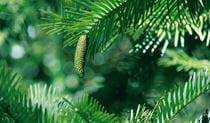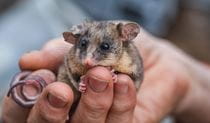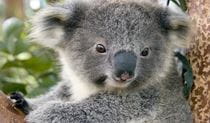Wollemi pine
The Wollemi pine is one of the world’s oldest and rarest trees. Only 46 adult trees and 43 juveniles remain in the wild. Belonging to a 200 million year-old plant family, this critically endangered Australian species is considered a global treasure.
A great survival story
The Wollemi pine is an ancient conifer that’s sometimes called a living fossil, or the ‘dinosaur tree’. Fossil evidence of the species dates back 91 million years. It was thought to have gone extinct around 2 million years ago, until the chance discovery in 1994 of small grove of living trees in a remote rainforest canyon of the Greater Blue Mountains.
In this microclimate Wollemi pines can grow up to 40m tall. Mature trees typically have more than one trunk and can produce up to 40 trunks on a single tree. A single trunk may reach up to 450 years old. Some of the larger trees could be hundreds, if not thousands, of years old.
The species has distinctive, deep-red, bubbly bark and fern-like foliage. Male and female cones are produced on the same tree, and the seeds have a single wing to help them disperse in wind.
Wollemi pine historic discovery
Journey back in time with the Wollemi pine. This prehistoric tree survived the age of dinosaurs and was only rediscovered in 1994. Learn about its incredible story and why protecting this botanical treasure is so important.
Under threat
With so few adult trees remaining in the wild the species is at risk of extinction. The biggest threats to its existence include catastrophic fire events and, in particular, human disturbance. Unauthorised visits to the site risk compromising the fragile wild population and ecosystem. Trampling seedlings, damaging exposed roots and fragile soils, and introducing invasive weeds and pathogens like deadly Phytophthora cinnamomi or ‘root rot’ all have a devastating impact.
Visit our Wollemi pine conservation project page to learn more about what NSW National Parks and our partners are doing to safeguard the future of the Wollemi pine.
Wollemi pine threats and protection
The Wollemi pine needs your help! This prehistoric tree, once thought extinct, is now critically endangered. Learn about the threats it faces and how you can make a difference, ensuring this botanical wonder survives for generations to come.
Where to see Wollemi pines safely
To help protect the last wild population of Wollemi pines from human disturbance and introduced weeds and diseases, this sensitive site isn't accessible to the public. Successful cultivation of the Wollemi pine means you can safely enjoy this critically endangered species in botanic gardens across Australia including:
NSW
- Royal Botanic Garden Sydney, Mrs Macquaries Road, Sydney NSW (see Wollemi pine location on map)
- Australian Botanic Garden, Mount Annan NSW
- Blue Mountains Botanic Garden, Mount Tomah NSW
Outside NSW
- Adelaide Botanic Garden, Adelaide SA
- Brisbane Botanic Garden Mt Coot-tha, Brisbane Qld
- Kings Park and Botanic Garden, Perth WA
- Mount Lofty Botanic Garden, Piccadilly SA
- National Arboretum Canberra, Molonglo Valley ACT
- Royal Botanic Garden Victoria - Cranbourne Gardens, Cranbourne Vic
- Royal Tasmanian Botanical Garden, Hobart Tas
In your own garden?
You can help with conservation of this ‘dinosaur tree’ by growing your own. They're available from many garden nurseries and are easy to keep in a pot or indoors.
Plant facts
- Common name
- Wollemi pine
- Scientific name
- Wollemia nobilis
- Conservation status in NSW
- Critically endangered
Extra special protections
The Wollemi pine site in the Blue Mountains World Heritage Area is the first declared Asset of Intergenerational Significance (AIS) in NSW. This historic declaration recognises the global significance of the Wollemi pine, and provides the strongest legal protections in NSW national parks. Learn more about AIS.
You might also like
-

Wollemi pine conservation project
With less than 50 adult trees remaining in the wild, the critically endangered Wollemi pine is at very high risk of extinction. NSW National Parks and...
-

Assets of Intergenerational Significance (AIS)
Assets of Intergenerational Significance (AIS) are declared to bolster protections for an area with exceptional environmental or cultural values, like...
-

Protecting threatened species in parks
Around 84% of the approximately 900 threatened species in NSW are found in our national parks and reserves. Find out what we're doing to protect threa...
-

Saving our Species conservation program
Today, we're at risk of losing nearly 1000 of our state's native animals and plants. That's why the NSW Government established Saving our Species. It'...







